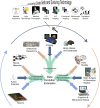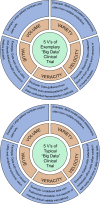The evolution of Big Data in neuroscience and neurology
- PMID: 37441339
- PMCID: PMC10333390
- DOI: 10.1186/s40537-023-00751-2
The evolution of Big Data in neuroscience and neurology
Abstract
Neurological diseases are on the rise worldwide, leading to increased healthcare costs and diminished quality of life in patients. In recent years, Big Data has started to transform the fields of Neuroscience and Neurology. Scientists and clinicians are collaborating in global alliances, combining diverse datasets on a massive scale, and solving complex computational problems that demand the utilization of increasingly powerful computational resources. This Big Data revolution is opening new avenues for developing innovative treatments for neurological diseases. Our paper surveys Big Data's impact on neurological patient care, as exemplified through work done in a comprehensive selection of areas, including Connectomics, Alzheimer's Disease, Stroke, Depression, Parkinson's Disease, Pain, and Addiction (e.g., Opioid Use Disorder). We present an overview of research and the methodologies utilizing Big Data in each area, as well as their current limitations and technical challenges. Despite the potential benefits, the full potential of Big Data in these fields currently remains unrealized. We close with recommendations for future research aimed at optimizing the use of Big Data in Neuroscience and Neurology for improved patient outcomes.
Supplementary information: The online version contains supplementary material available at 10.1186/s40537-023-00751-2.
Keywords: Addiction; Alzheimer’s; Artificial Intelligence; Big data; Brain Stimulation; Depression; Neurology; Neuroscience; Pain; Stroke.
© The Author(s) 2023.
Conflict of interest statement
Competing interests"TW and LD are officers at Highland Instruments, a medical device company. They have patents pending or issued, personally or as officers in the company, related to imaging, brain stimulation, diagnostics, modeling, and simulation."
Figures





Similar articles
-
Integrating Big Data, Artificial Intelligence, and motion analysis for emerging precision medicine applications in Parkinson's Disease.J Big Data. 2024;11(1):155. doi: 10.1186/s40537-024-01023-3. Epub 2024 Oct 30. J Big Data. 2024. PMID: 39493349 Free PMC article.
-
The future of Cochrane Neonatal.Early Hum Dev. 2020 Nov;150:105191. doi: 10.1016/j.earlhumdev.2020.105191. Epub 2020 Sep 12. Early Hum Dev. 2020. PMID: 33036834
-
Quantitative skills in undergraduate neuroscience education in the age of big data.Neurosci Lett. 2021 Aug 10;759:136074. doi: 10.1016/j.neulet.2021.136074. Epub 2021 Jun 18. Neurosci Lett. 2021. PMID: 34147539
-
Medical Digital Twin: A Review on Technical Principles and Clinical Applications.J Clin Med. 2025 Jan 7;14(2):324. doi: 10.3390/jcm14020324. J Clin Med. 2025. PMID: 39860329 Free PMC article. Review.
-
Shaping a data-driven era in dementia care pathway through computational neurology approaches.BMC Med. 2020 Dec 16;18(1):398. doi: 10.1186/s12916-020-01841-1. BMC Med. 2020. PMID: 33323116 Free PMC article. Review.
Cited by
-
New Challenges for Anatomists in the Era of Omics.Diagnostics (Basel). 2023 Sep 15;13(18):2963. doi: 10.3390/diagnostics13182963. Diagnostics (Basel). 2023. PMID: 37761332 Free PMC article. Review.
-
Personalized medicine in old age psychiatry and Alzheimer's disease.Front Psychiatry. 2024 May 1;15:1297798. doi: 10.3389/fpsyt.2024.1297798. eCollection 2024. Front Psychiatry. 2024. PMID: 38751423 Free PMC article. Review.
-
Artificial Intelligence and Neuroscience: Transformative Synergies in Brain Research and Clinical Applications.J Clin Med. 2025 Jan 16;14(2):550. doi: 10.3390/jcm14020550. J Clin Med. 2025. PMID: 39860555 Free PMC article. Review.
-
Framing and Management of Migraines in Women: An Expert Opinion on Challenges, Current Approaches, and Future Multidisciplinary Perspectives.Healthcare (Basel). 2025 Jan 16;13(2):164. doi: 10.3390/healthcare13020164. Healthcare (Basel). 2025. PMID: 39857191 Free PMC article.
-
Personal brain and Spatiotemporal Psychopathology - Intrinsic vs. extrinsic sources of interindividual variability.Mol Psychiatry. 2025 Mar;30(3):1164-1166. doi: 10.1038/s41380-024-02783-3. Epub 2024 Oct 16. Mol Psychiatry. 2025. PMID: 39414937 Free PMC article. No abstract available.
References
-
- Massachusetts Institute of Technology DoDC. Neurosciences Research Program Records, AC-0107, box X (Schmitt, Francis Otto). 1986 [Available from: https://archivesspace.mit.edu/repositories/2/resources/83].
-
- Trappenberg TP. Fundamentals of Computational Neuroscience. United States: Oxford University Press; 2010.
Grants and funding
LinkOut - more resources
Full Text Sources
